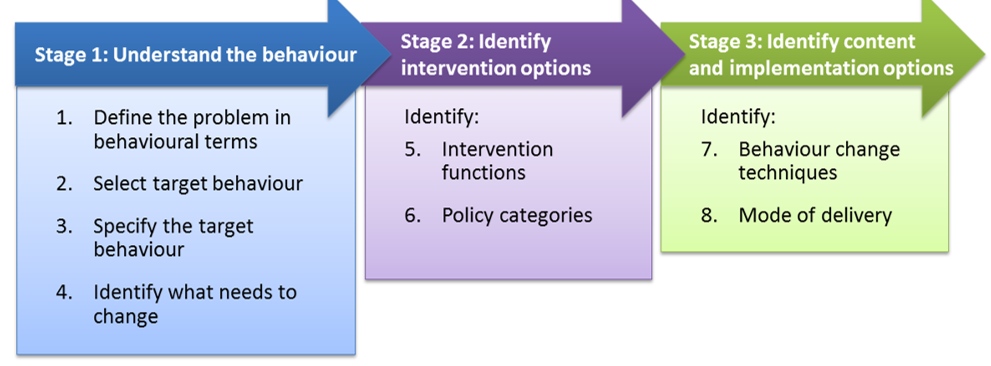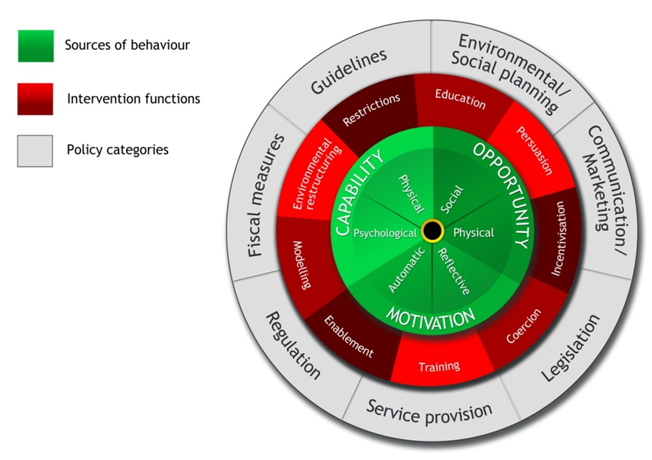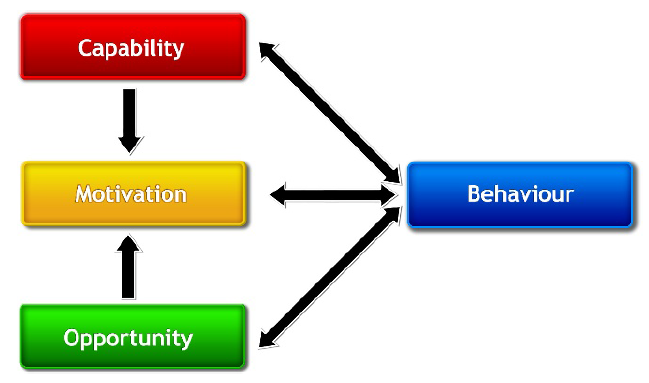The Behaviour Change Wheel: using psychology to encourage healthier and more sustainable choices
In the context of the coronavirus pandemic, the UK government has sought advice from both nudge1 and Behaviour Change Wheel (BCW)2 specialists to encourage positive behaviour. But this theory isn’t just limited to government; the grocery retail industry could do more to employ both theories to guide their behaviour change policies too.
Nudge theory has already been applied to retail with great effect (see my previous piece on this here), and the BCW can be used to support this initiative, as well as being a successful independent strategy.
The Behaviour Change Wheel
The Behaviour Change Wheel is a framework designed to create a change in behaviour, such as encouraging customers to be healthier or more sustainable.
- The wheel is made up of 19 different behaviour change frameworks including nudge theory3. Unlike nudge, this can allow for financial incentives including price, promotion and loyalty programmes.
- The BCW provides a step by step guide as to how to change behaviour, and materials covering the following three stages4:
The process of the BCW5
Whilst this prescriptive process may lack creative flare, it does break the thought process into manageable stages. When used at the outset of a behaviour change process, it can easily become part of an overarching strategy.
- The BCW provides a flexible framework which can be applied:
- To different contexts, from healthy diets6 and physical exercise7 to saving energy8. increasing recycling9 and digital10
- From the beginning of a project or simply to look back and assess why a behaviour change failed11
- To both qualitative and quantitative research contexts12
- To individuals and large or small groups 5.
- To one-off and repeated behaviours5
- To assess the viability of a behaviour change through its APEASE criteria (Affordability, Practicability, Effectiveness and cost-effectiveness, Acceptability, Side-effects/safety, Equity)5
A closer look at the Wheel
At the BCW’s hub sits the COM-B Model (in green) which states that Capability, Opportunity and Motivation are needed to change Behaviour. Each component can be broken into two areas, for example motivation can be automatic (i.e. subconscious) or reflective (i.e. conscious).
The Behaviour Change Wheel13
Surrounding the COM-B model are the Intervention functions (in red) that can be used to create the behaviour change. The outer wheel (in grey) provides public policy categories that may be used to change behaviour.
Definitions for the intervention functions are outline in the table below:
| Function | Definition | Real world example |
|---|---|---|
| Education | Increasing knowledge or understanding | Providing information to promote healthy eating |
| Persuasion | Using communication to induce positive or negative feelings or stimulate action | Using imagery to motivate increases in physical activity |
| Incentivisation | Creating an expectation of reward | Using prize draws to induce attempts to stop smoking |
| Coercion | Creating an expectation of punishment or cost | Raising the financial cost to reduce excessive alcohol consumption |
| Training | Imparting skills | Advanced driver training to increase safe driving |
| Restriction | Using rules to reduce the opportunity to engage in the target behaviour (or to increase the target behaviour by reducing the opportunity to engage in competing behaviours) | Prohibiting sales of solvents to people under 18 to reduce use for intoxication |
| Environmental restructuring | Changing the physical or social context | Providing on-screen prompts for GPs to ask about smoking behaviour |
| Modelling | Providing an example for people to aspire to or imitate | Using TV drama scenes involving safe-sex practices to increase condom use |
| Enablement | Increasing means/reducing barriers to increase capability (beyond education and training) or opportunity (beyond environmental restructuring) | Behavioural support for smoking cessation, medication for cognitive deficits, surgery to reduce obesity, prostheses to promote physical activity |
Intervention function definition and examples4
The relationship between the components of the COM-B model can be summarised in figure 2 below:
The COM-B System13
A typical example to explain how these components work together, is the encouragement of cycling4. To own a bike would increase the Opportunity, to know how to cycle would increase the Capability. An increase in both the Opportunity and the Capability would increase the Motivation to cycle. In turn, this is more likely to lead to a behaviour change.
So how does this apply to retail?
Applying the Behaviour Change Wheel to a commercial context undoubtedly needs adaptation. For example, it may be worth replacing or adding to the public policy categories (in grey). I’ve already touched on retail policies like price, promotion and loyalty programmes, but there are numerous others including:
- Category management
- The buying process (online, offline, pay as you scan, self-service checkouts)
- Staff (particularly relevant to educating and training customers)
- The physical store and ambience
- In store media
- Out of store media
- Personalised offers (once again using customer loyalty as a vehicle for behaviour change)
The future of the BCW
The main advantage of the BCW is that it is an amalgamation of 19 frameworks, however this scale means there can be a risk of watering down these frameworks, like nudge theory. For this reason, it may be prudent to run the frameworks alongside each other.
It should not be forgotten that habit formation should remain the gold standard of any behaviour change. Whilst the Behaviour Change Wheel and nudge theories incorporate habit formation, its importance can easily be lost in the mix.
Retail need to find ways to support the ever-increasing emphasis on areas like health and sustainability. Therefore, it may only be a matter of time before the BCW and the COM-B model are spoken of as frequently as nudge theory.
References
1 https://www.instituteforgovernment.org.uk/explainers/nudge-unit
2 https://www.instituteforgovernment.org.uk/events/scientific-advice-government-coronavirus-crisis
3 Dolan, P., Hallsworth, M., Halpern, D. et al (2012). Influencing behaviour: the mindspace way. Journal of Economic Psychology 33 (1): 264–277
4 Michie S, Atkins L, and West R (2014). A guide to using the Behaviour Change Wheel. London: Silverback Publishing.
5 Michie, S., Atkins, L. and Gainforth, H. (2016). Changing behaviour to improve clinical practice and policy. In: Novos desafios, novas competȇncias: contributos atuais da psicologia 2016. AxiomaPublicac¸oes da Faculdade de Filosofia: 41-60
6 Atkins L and Michie S (2015). Designing interventions to change eating behaviours. Proceedings of the Nutrition Society 74:164–70.
7 Martin, R., and Murtagh, E.M (2015). An intervention to improve the physical activity levels of children: design and rationale of the ‘Active Classrooms’ cluster randomised controlled trial. Contemporary clinical trials 41: 180-191.
8 Staddon, S.C., Cycil, C., Goulden, M., et al (2016) Intervening to change behaviour and save energy in the workplace: a systematic review of available evidence. Energy Research & Social Science 17: 30-51.
9 Gainforth H, Sheals K, Atkins L, Jackson R, Michie S. 2016 Developing interventions to change recycling behaviors: a case study of applying behavioral science. Applied Environment Education and Communication 15:4. http://dx.doi.org/10.1080/1533015X.2016.1241166.
10 Garnett, C., Oldham, M., Colin, C. et al (2021). Evaluating the effectiveness of the smartphone app, Drink Less, compared with the NHS alcohol advice webpage, for the reduction of alcohol consumption among hazardous and harmful adult drinkers in the UK at six-month follow-up: protocol for a randomised controlled trial. Addiction 116
11 Direito, A., et al (2017). Application of the behaviour change wheel framework to the development of interventions within the City4Age project. IEEE 25th International Conference on Software, Telecommunications and Computer Networks (SoftCOM). Split, Croatia: IEEE.
12 Timlin D., McCormack J.M., and Simpson, L. (2020). Using the COM-B model to identify barriers and facilitators towards adoption of a diet associated with cognitive function (MIND diet): barriers and facilitators to the MIND diet. Public Health Nutrition:1–14.
13 Michie, S., van Stralen, M.M. and West, R (2011): The behaviour change wheel: A new method for characterising and designing behaviour change interventions. Implementation Science 6:42
The latest insights from our experts around the world






